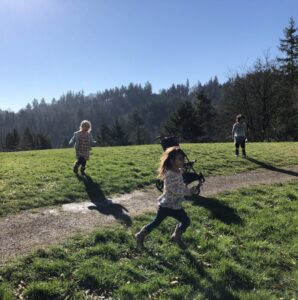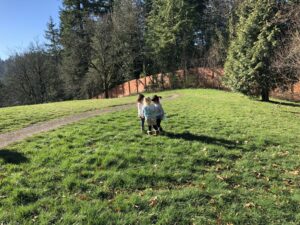Reworking Scary Experiences Through Play

[vc_row][vc_column][vc_column_text]
A child’s play is not simply a reproduction of what they have experienced, but a creative reworking of the impressions they have acquired.
Each week, the Cottonwood community of kindergarteners and first-graders hikes in Hoyt Arboretum. Last Tuesday, we hiked to the Upper Meadow, where the children had time to free play. They rolled down a large grassy hill, dug into the dirt with spoons, noticed markings on trees, and built leaf piles.
About halfway through our time in the Upper Meadow, something unexpected and scary happened. A dog who was off-leash came running into the area where we were playing and began barking at and chasing some children. Many children were frightened, holding their friends and holding onto teachers’ legs. Thankfully, no one was hurt and the dog’s owner arrived shortly afterwards and was able to secure her dog back on its leash.
As teachers, once the immediate danger was over and we ensured everyone was okay, we stepped back to observe how the children moved forward in the moments following. Some children continued to hug each other and stay near the teachers; others found quiet places to sit and reflect for a few moments; some jumped right back into their play.
We observed three children immediately begin to reenact the scary moments. Simone (who had been chased by the dog just moments before) turned to Amanda and said, “Pretend I’m a mean dog and I’m chasing you!” Amanda began to run away from Simone, as Simone barked and growled. Anne joined in while Simone chased them both in circles, showing her teeth and claws.

As time passed, we noticed their game slowly beginning to transform from a reenactment of what had just happened. First, the children running from Simone began to laugh and tease the dog saying, “Come and get us, puppy!” and then dashing away moments before the dog could get them. After this, the children came together for a brief moment and Simone stepped out of the role of the dog and Amanda stepped into it. However, Amanda was not scary at all. She was a friendly puppy who the other children played fetch with. They threw sticks for Amanda to retrieve, patted her on the head, and made a comfortable bed for her in the grass.

In these moments, we noticed the children reworking their impressions of the dog, as Vygotsky describes, through play. They began by reenacting the scary experience they had just had and then slowly moved into creating a new puppy character who was perhaps more similar to their schema with dogs: a puppy that was playful and loving. The dog transformed from something to be feared and hidden from to a creature the children were playing with and taking care of. Play was a vehicle for these children to revisit the emotions of their surprising – and for some scary – experience. It offered them the chance to do this in a context that presented no real danger, therefore leaving them free to rework the story and transform it into one where they had the agency to make decisions and change what unfolded.
We are wondering:
What struggles or experiences are you observing children reworking through play?
How are children you work with using play to develop agency?[/vc_column_text][/vc_column][/vc_row]
